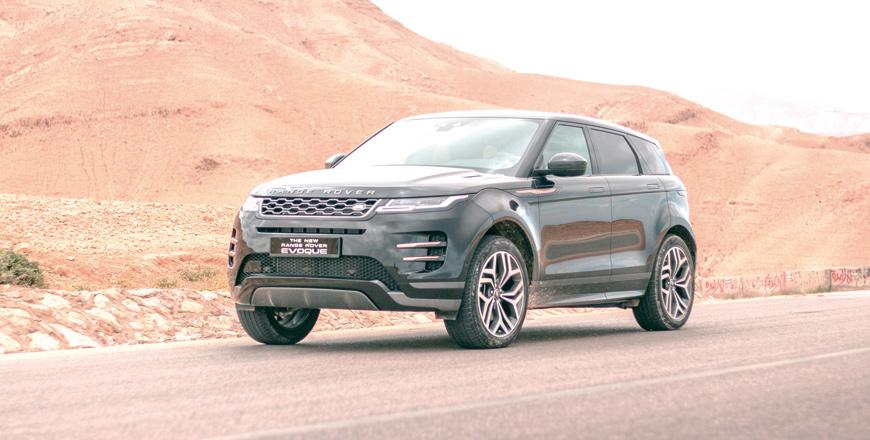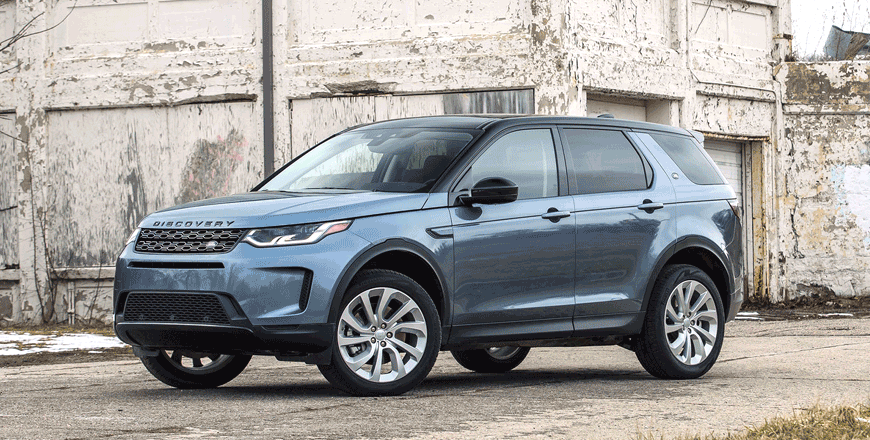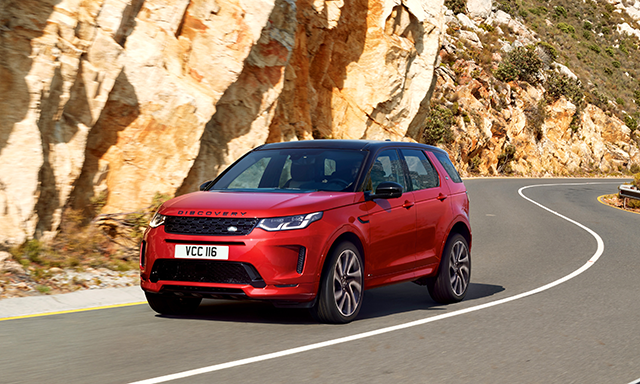You are here
Range Rover Evoque P300 S AWD: Pick of the range
By Ghaith Madadha - Jun 17,2019 - Last updated at Jun 17,2019

Photo courtesy of Range Rover
Low, wide, highly stylised and built on a transverse front-drive based platform, the original Evoque proved equally controversial with Land Rover traditionalists and popular with a newer, younger and more fashion-conscious clientele when first launched in 2011.
Influencing the design of almost every Land Rover since, the second generation arrived earlier this year and is instantly recognisable as an Evoque, yet blends seamlessly into the brand’s modern model line-up. The new Evoque also incorporates improved luxury, space, efficiency, and significant tech advances including standard mild hybrid technology for most models.
Keeping up appearances
Echoing the original’s design cues yet with more rounded surfacing replacing stark edges and angular lines, the new Evoque looks bulkier and more upright owing to its higher waistline and bonnet, but is only slightly bigger. Retaining its predecessor’s main design cues including a rakishly descending and floating effect coupe-like roofline, sense of width, and clamshell bonnet, the new model receives even slimmer front and rear lights. Offered only as a 5-door, with the 3-door coupe version ditched, it also gains a standard pop-out door handles and a more prominently ridged side character line.
Offered with three petrol and variations regionally, the Evoque can also be had in several specification levels including additional sporty R-Dynamic and Black Pack styling variations. Driven in four variations during its recent Middle East launch is at first glance seemingly most desirable in top spec First Edition guise with the most aggressive styling, biggest alloy wheels, most luxurious cabin and optional adaptive suspension. It was, however, the P300 S specification, mating the most powerful engine with the least adorned styling and most basic — albeit still very generously luxurious — equipment specification that proved best.
Seamless and smooth
Driven by the most powerful of Jaguar Land Rover’s turbocharged 2-litre 4-cylinder Ingenium engines, the Evoque P300 utilises a 48v mild hybrid electric vehicle (MHEV) system, which is subtle and seemingly seamless in its driving contribution during acceleration and in traffic. Recovering kinetic energy on deceleration and, the MHEV system allows the engine to switch off automatically at under 17km/h when coming to a stop. In combination with a smooth and responsive 9-speed automatic gearbox with a broad range of ratios, MHEV helps the hefty 1,850kg P300’s achieve moderate 8.1l/100km combined cycle fuel efficiency.
Developing 296BHP at 5,500rpm and
295lb/ft torque throughout a broad and flexibly accessible 1,500-4,500rpm rev band the Evoque P300 drives with brisk and responsive versatility. Accelerating through 80-120km/h in 4.5-seconds, the P300 overtakes and climbs inclines with confident easy and an athletic pace. Capable of 242km/h, the P300 is also brisk on acceleration, with its four-wheel-drive sending power to the rear axles for additional traction when needed, while its MHEV driving contribution seems to compensate for turbo lag to make it more responsive as its races through 0-100km/h in 6.6-seconds.
Better basics
Driven in three versions in P300 guise, the Evoque proved refined and reassuringly stable at speed, tidy into and grippy through corners where it was amenable to cornering line corrections. Meanwhile its steering was quick and direct, and its MacPherson strut front and integral link rear suspension well balanced ride comfort and handling. However, it was the less aggressively decorated base S specification that proved the best drive. Slightly slimmer, taller and more forgiving the P300 S’ 235/60R18 tyres were more absorbent than the R-Dynamic’s firm 235/50R20s and the First Edition’s yet firmer 245/45R21 tyres.
Comfortably absorbing bumps, lumps and imperfections in a natural and fluent manner as paired with fixed rate dampers, the P300 S’s character was more consistent than the First Edition’s use of three-mode adaptive dampers to alternately provide both a softer and firmer ride. Settled and with good vertical and lateral control, the S version’s more restrained tyre size also provided better road feel, which made it seem more agile, nimble and connected through narrow winding roads. With minor steering feel improvement, one felt more confident placing, manoeuvring and hustling the S through such switchbacks.
Ability and equipment
Normally driving front wheels to reduce consumption but engaging all four wheels when necessary, the road-biased Evoque is, as Land Rovers are, nevertheless adept off-road, with generous off-road angles, 212mm clearance and 600mm water wading ability. Moreover, it features a sophisticated suite of off-road driving assistance systems including All-Terrain Progress Control and four-mode Terrain Response system that utilises and adapts different electronic driver aids, gearbox and throttle for different off-road situations. Numerous other features include blind spot monitoring, autonomous emergency braking, 360° reversing camera, high mounded rear camera projecting a clearer image in the rearview mirror and an optional low front camera for improved off-road visibility.
Classy, well-equipped and with comfortably supportive driving position and uncluttered design inside, the Evoque’s functions are concentrated in its infotainment screens, while materials are mostly high quality. Rear room is fairly sized but rear ingress could be slightly better for larger occupants, while boot capacity is generous. Offered with various trim levels and colours including sportier, darker and contrasting schemes for upscale versions, the base S version’s grey fabric upholstery, tactile and grippy steering material and light use of wood, however, made for a more fresh and airy ambiance.
TECHNICAL SPECIFICATIONS
Engine: 2-litre, turbocharged, transverse 4-cylinders
Bore x stroke: 83 x 92.3mm
Compression ratio: 9.5:1
Valve-train: 16-valve, DOHC, continuously variable valve timing, direct injection
Electric motor: Synchronous claw pole rotor
Battery: 46.2v lithium-ion
Gearbox: 9-speed automatic, four-wheel-drive
Ratios: 1st 4.713; 2nd 2.842; 3rd 1.909; 4th 1.382; 5th 1.0; 6th 0.808; 7th 0.699; 8th 0.58; 9th 0.48
Reverse/final drive: 3.83/4.544
Power, BHP (PS) [kW]: 296 (300) [221] @5,500rpm
Specific power: 148.1BHP/litre
Power-to-weight ratio: 153.7BHP/tonne (kerb)
Torque, lb/ft (Nm): 295 (400) @1,500-4,500rpm
Specific torque: 200.2Nm/litre
Torque-to-weight ratio: 207.8Nm/tonne (kerb)
0-100km/h: 6.6-seconds
80-120km/h: 4.5-seconds
Top speed: 242km/h
Fuel economy, combined: 8.1-litres/100km
CO2 emissions, combined: 186g/km
Fuel capacity: 67-litres
Wheelbase: 2,681mm
Track, F/R: 1,625/1,631mm
Ground clearance: 212mm
Approach/break-over/departure angles: 25/20.7/30.6 degree
Ascent/descent gradient: 45 degree
Side slope gradient: 35 degree
Towing, braked/unbraked: 1,800/750kg
Aerodynamic drag co-efficiency: 0.33
Boot capacity, min/max: 591-/1,383-litres
Unladen/kerb weight: 1,850/1,925kg
Suspension, F/R: Double wishbones/integral multi-link, anti-roll bars
Steering: Electric-assisted rack & pinion
Turning circle: 11.6-metres
Lock-to-lock: 2.31-turns
Brake discs, F/R: 349mm/325mm
Tyres: 235/60R18
Related Articles
AMMAN — Somewhat controversial with Land Rover traditionalists when first launched in 2011, the compact Range Rover Evoque, however, popular
A more affordable and family-oriented Land Rover SUV with compact dimensions and plenty of practicality, the Discovery Sport was at home bot
First launched in 2015 and revised for the current model year, the Land Rover Discovery Sport’s subtle aesthetic refresh is combined with a


















